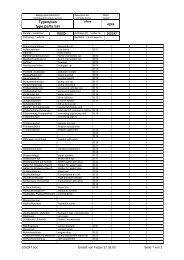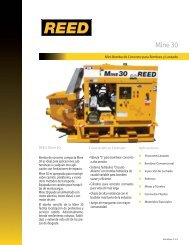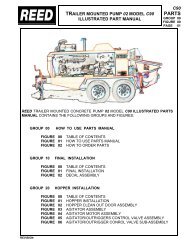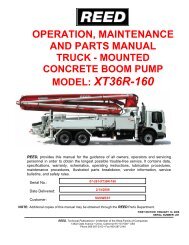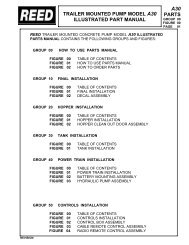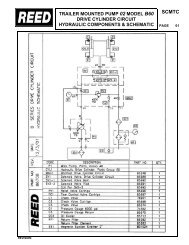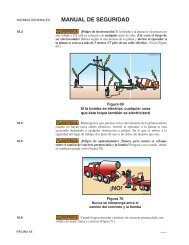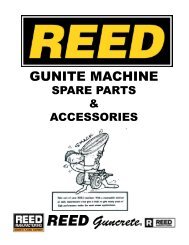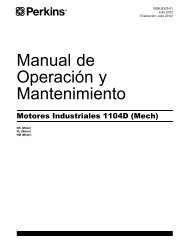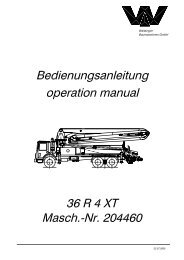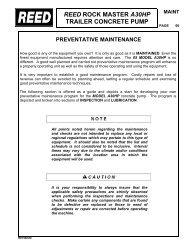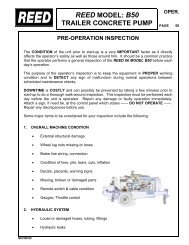Perkins Motor Operation and Maintenance Manual (English) - REED
Perkins Motor Operation and Maintenance Manual (English) - REED
Perkins Motor Operation and Maintenance Manual (English) - REED
You also want an ePaper? Increase the reach of your titles
YUMPU automatically turns print PDFs into web optimized ePapers that Google loves.
72 SEBU8325-01<br />
<strong>Maintenance</strong> Section<br />
Fuel Tank Water <strong>and</strong> Sediment - Drain<br />
Fuel Tank<br />
Fuel quality is critical to the performance <strong>and</strong> to the<br />
service life of the engine. Water in the fuel can cause<br />
excessive wear to the fuel system.<br />
Water can be introduced into the fuel tank when the<br />
fuel tank is being filled.<br />
Condensation occurs during the heating <strong>and</strong> cooling<br />
of fuel. The condensation occurs as the fuel passes<br />
through the fuel system <strong>and</strong> the fuel returns to the<br />
fuel tank. This causes water to accumulate in fuel<br />
tanks. Draining the fuel tank regularly <strong>and</strong> obtaining<br />
fuel from reliable sources can help to eliminate water<br />
in the fuel.<br />
Drain the Water <strong>and</strong> the Sediment<br />
Illustration 42<br />
Typical example<br />
(4) O ring seal<br />
g02659219<br />
4. Lubricate the sealing ring (4) with clean fuel oil.<br />
5. Install the spin-on filter (2) into the top of the filter<br />
head (1).<br />
6. Tighten the spin-on filter by h<strong>and</strong> until the sealing<br />
ring contacts the filter head. Rotate the spin-on<br />
filter through 90 degrees.<br />
7. Prime the fuel system. Refer to <strong>Operation</strong> <strong>and</strong><br />
<strong>Maintenance</strong> <strong>Manual</strong>, “Fuel System - Prime”.<br />
i02677376<br />
Fuel Tank Water <strong>and</strong> Sediment<br />
-Drain<br />
NOTICE<br />
Care must be taken to ensure that fluids are contained<br />
during performance of inspection, maintenance, testing,<br />
adjusting, <strong>and</strong> repair of the product. Be prepared<br />
to collect the fluid with suitable containers before<br />
opening any compartment or disassembling any component<br />
containing fluids.<br />
Dispose of all fluids according to local regulations <strong>and</strong><br />
m<strong>and</strong>ates.<br />
Fuel tanks should contain some provision for draining<br />
water <strong>and</strong> draining sediment from the bottom of the<br />
fuel tanks.<br />
Open the drain valve on the bottom of the fuel tank<br />
in order to drain the water <strong>and</strong> the sediment. Close<br />
the drain valve.<br />
Check the fuel daily. Allow five minutes after the<br />
fuel tank has been filled before draining water <strong>and</strong><br />
sediment from the fuel tank.<br />
Fill the fuel tank after operating the engine in<br />
order to drive out moist air. This will help prevent<br />
condensation. Do not fill the tank to the top. The<br />
fuel exp<strong>and</strong>s as the fuel gets warm. The tank may<br />
overflow.<br />
Some fuel tanks use supply pipes that allow water<br />
<strong>and</strong> sediment to settle below the end of the fuel<br />
supply pipe. Some fuel tanks use supply lines that<br />
take fuel directly from the bottom of the tank. If<br />
the engine is equipped with this system, regular<br />
maintenance of the fuel system filter is important.<br />
Fuel Storage Tanks<br />
Drain the water <strong>and</strong> the sediment from the fuel<br />
storage tank at the following intervals:<br />
• Weekly<br />
• Service intervals<br />
• Refill of the tank<br />
This will help prevent water or sediment from being<br />
pumped from the storage tank into the engine fuel<br />
tank.



